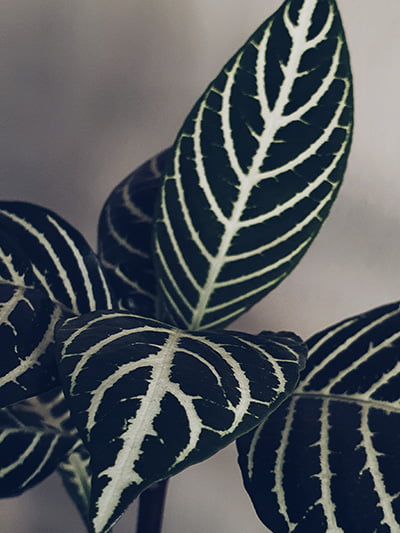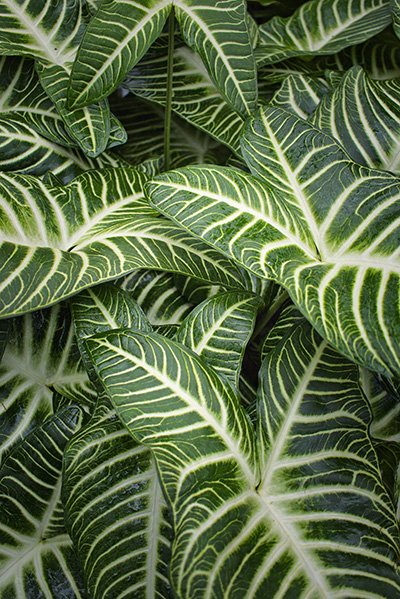The zebra plant (Aphelandra squarrosa) is a popular houseplant because of its high-contrast leaves - but its blooms are the real showstopper! The problem is that it can be a finicky plant; without proper care, you won't enjoy those bright yellow flowers.
We are here to help your zebra plant flourish! Below, we'll go into detail on how to care for a zebra plant and the growing tips you need to know to make your zebra plant happy.
Botanical Name
Common Name
Plant Type
Mature Size
Sun Requirement
Soil Type
Hardiness Zone
Pet Friendly
Aphelandra squarrosa
Zebra plant
Annual
1-2 feet in height and 1-2 feet in width
Partial, bright light
Well-draining
11-12 (USDA)
Yes
What Is a Zebra Plant?
The zebra plant (Aphelandra squarrosa) is native to southern Brazil, where it thrives in a humid environment shaded by the canopies of jungle forests. In its natural environment, the zebra plant has a climbing growth pattern - but you won't see that when it's kept in a pot. As a houseplant, it will stay under 2 feet tall.
Zebra plants are showy! The dark green leaves are heavily striped with bright white veins, making it clear why it's called the "zebra" plant. Many houseplant lovers who haven't yet landed on the ideal care for a zebra plant still delight in their beautiful foliage!
However, it's the flowers that truly make the zebra plant shine. Twice per growing season, the zebra plant will shoot up a 4-inch flower bract, bursting into yellow conical blooms! These flower bracts will bloom for about six weeks before fading away, making zebra plants a very showy indoor plant!
Zebra Plant Care Requirements
Light
The Zebra plant is a rainforest plant that grows under the canopy of tall trees. Although the zebra plants receive an ample amount of light, it is all sifted through the branches above, resulting in filtered and not direct sunlight with a dappled effect. Zebra plants require ample amounts of bright, indirect light. The leaves may scorch and develop brown tips when exposed to excessive light or direct sunlight. Conversely, insufficient light can hinder the plant's ability to produce flower heads.
Set your zebra plant in a location that receives lots of indirect sunlight. A south-facing window works well. Because the morning sun is typically mild, you can try placing it near an east-facing window. If your plant shows signs of receiving too much sun, consider covering the window with a sheer curtain to help diffuse the bright light.
Water
Aphelandra squarrosa is a bit particular when it comes to watering. Use filtered water that is just slightly warmer than room temperature.
Zebra plants are sensitive to both excess moisture and lack of moisture. You'll need to keep the soil consistently moist during the active growing season, which requires your watchfulness. They love moist but not wet soil. It's unlikely that you'll be able to water your zebra plant according to a regular schedule. Always check to see if the top inch of the soil is moist before watering, and ensure the pot has a drainage hole.
During the winter dormancy, the soil can dry out somewhat, and it should only be watered when the soil is completely dry. To determine whether it is necessary to water your plant, insert your finger approximately an inch into the soil; if the soil feels dry, it is time to water.
Watering zebra plants from the bottom is considered one of the most effective methods. You can achieve this by placing the pot in a dish of water, allowing the soil to absorb the water from the bottom. Allow the soil to soak up the water for about 30 minutes, then remove the pot from the dish and let the excess water drain out of the pot's bottom drainage holes. Make sure to avoid leaving your plant in stagnant water, as this can result in root rot.
Temperature
The zebra plant prefers temperatures between 65 and 80 degrees Fahrenheit. Thankfully, this is likely the temperature range your home sits at already! Ensure your zebra plant isn't located near cold drafts from doorways and chimneys.
Zebra plants can be grown outdoors on a porch or greenhouse, but it's important that it only spends a little bit of time in temperatures cooler than 55 degrees Fahrenheit. Chilly temperatures will cause the plant to go dormant and eventually die. You may need to bring your zebra plant indoors when the night gets cold.
However, zebra plants do rely on cooler temperatures to signal their flowering patterns. Once your zebra plant blooms in the summer and the flower bract fades, clip it back and move it to a cooler location, and it needs to regather its nutrients and root strength during this dormant period. Move it back to a warm location in the spring to encourage blooming.

Source: Unsplash
Humidity
Zebra plants love high humidity! Maintaining humidity levels of 60-70% indoors can be difficult. Here are a few tricks to try to boost the humidity of the air around your zebra plant.
Pebble Tray
You can make a humidity tray by filling a tray with pebbles and then adding water until it reaches just below the tops of the pebbles. Set your zebra plant pot on top of the pebbles. The pebbles will keep the pot out of the water, but as the water in the tray evaporates, it will add moisture to the air around it.
Group Houseplants
All plants naturally increase the humidity of the air around them. Make that work for you! Group your zebra plant near other houseplants, and they will help each other out.
Mist Leaves
You can mist the leaves of your zebra plant with warm, filtered water - but don't overdo it. Standing water left on the leaves can cause fungal issues.
Place In Bathroom
Your bathroom is likely the most humid room in your house! If the window receives enough light, move your zebra plant in there.
Humidifier
Place a small humidifier nearby, and run it regularly.
Soil
Your zebra plant needs well-draining soil that can still hold onto moisture, and it can be a tricky balance! If you'd like to use a standard potting mix, use one labeled for African violets. You can also blend your potting soil by mixing 1 part of garden soil with 1 part of sand or perlite, which helps the soil drain easily. Then, add two parts of peat moss or coconut coir to add moisture retention.
Fertilization
The zebra plant flower requires a burst of nutrients, so you'll need to fertilize your plant regularly if you want to enjoy those blooms. During the spring and summer, feed your zebra plant every 1 to 2 weeks with a water-soluble, quick-release fertilizer. It needs to have a balanced nutrient level.
There's no need to fertilize your Aphelandra squarrosa during its dormancy period.
Propagation
Zebra plant propagation can take place through either stem cuttings or air layering.
Stem Cuttings
Use clear sheers to cut a 4 to 6-inch length of the stem. Remove all but the top two leaves.
Dip the end of the cutting in the rooting hormone to encourage faster and more vigorous root development.
Plant the cutting in a small container containing a mixture of equal parts perlite and peat moss.
Position the container in an area with direct sun and ensure that the soil is kept damp.
In a few weeks, you will notice new roots! Move the pot to a location with indirect light, and continue to maintain moist soil.
Air Layering
Select a healthy stem, and strip off the central leaves along its length.
Use a clean knife to make an incision halfway through the stem. Use a toothpick to help keep the incision open, and cover the area with rooting hormone.
Envelop the cut area with damp sphagnum moss, and fasten it securely using plastic wrap.
You will see roots developing within six weeks. At this point, you may detach the stem from the mother plant and transfer it to a new pot.

Source: Pixabay
Common Problems When Growing Zebra Plants
Zebra plant care can be tricky, especially when you're trying to get it to bloom! It can feel like a juggling act between pests, diseases, and general care requirements. Let's troubleshoot some of the most common problems.
Pests
Zebra plants can struggle with whiteflies, aphids, mealybugs, spider mites, and fungus gnats. Although these pests harm the plant in slightly different ways, you'll approach each of them similarly. Remove as many insects as possible, either through sticky traps or by removing heavily-infested leaves. Next, apply insecticidal soap and neem oil to the leaves and soil.
Diseases
Like other humidity-loving plants, zebra plants are a prime target for fungal diseases. These include botrytis blight, leaf spots, and root rot. Treat these by first unpotting the plant, cutting away dead roots, and repotting in fresh soil. Change your watering habits, taking care not to overwater or splash water up on the stem and leaves of the zebra plant. Treat leaves with a copper fungicide spray.
Growth Issues
If the leaves start to turn brown, curled, or crunchy, it's a sign your plant is receiving too much direct light! Move it to a different location with more indirect light instead.
Underwatering
Tip wilt occurs when the soil is too dry. Consider giving your zebra plant a heavy watering once a month, allowing excess water to drain off before returning it to its location.
Overwatering
Overwatering is a common problem for zebra plants and can lead to root rot, a serious condition that can cause the plant to wilt, discolor, and eventually die. When the soil is consistently moist or wet, it can lead to a lack of oxygen around the roots, making them susceptible to rotting. Overwatering can also cause the leaves to turn brown or yellow, and the plant may appear wilted or mushy.
Not Flowering
No one wants to grow a zebra plant as a foliage plant, so what should you do if your zebra plant is not flowering?
Immature Plant
Zebra plants typically do not start flowering until they are mature, which can take several years. If your plant is young, it may simply need more time to reach maturity and start producing flowers.
Improper Sunlight and Watering
Insufficient light can impede flower production in your plant. Make sure the plant is in a bright indirect sunlight location, such as near a bright window or under grow lights. Both overwatering and underwatering can stress the plant, leading to a lack of flowering. Make sure the soil is well-draining and that you are watering the plant appropriately based on its watering needs.
Nutrient deficiencies
Zebra plants require certain nutrients to flower, such as phosphorus and potassium. Insufficient nutrients can also impede flowering in the plant. It is essential to regularly fertilize your plant with a balanced fertilizer to ensure it receives the necessary nutrients.
Is Zebra Plant Pet Friendly?
Zebra plants are non-toxic when ingested, but their sap may cause skin irritation. Many gardeners find that they need to wear gloves when repotting or propagating their zebra plants. Your pet's paws or mouth might likely get irritated if they try to explore this houseplant.
